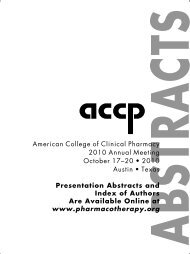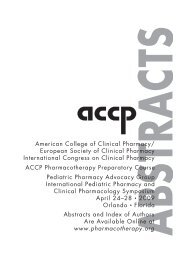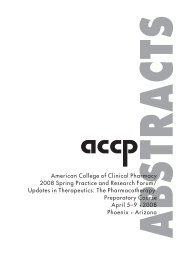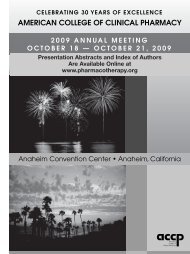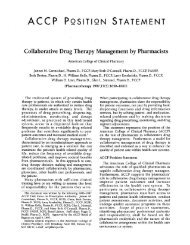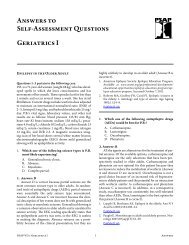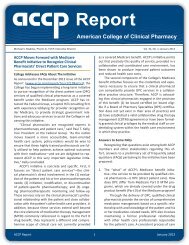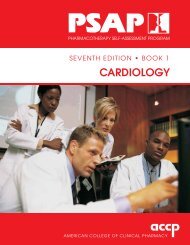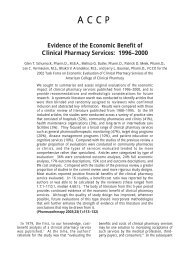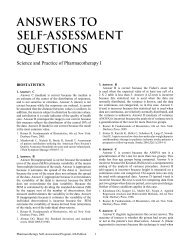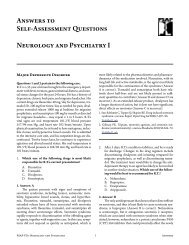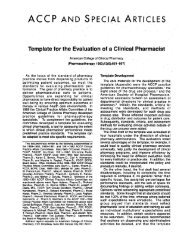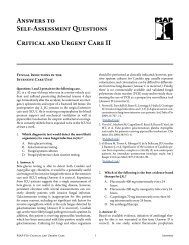Answers to Self-Assessment Questions - ACCP
Answers to Self-Assessment Questions - ACCP
Answers to Self-Assessment Questions - ACCP
Create successful ePaper yourself
Turn your PDF publications into a flip-book with our unique Google optimized e-Paper software.
(Answer D) occurs more often in patients receiving<br />
immunonutrition than those receiving PN, making Answer<br />
D the correct answer. Hyperglycemia (Answer A) and<br />
hypertriglyceridemia (Answer B) are both more common in<br />
patients receiving PN than in those receiving any form of<br />
EN, making Answer A and Answer B incorrect. Because of<br />
interruptions in the delivery of EN caused by GI in<strong>to</strong>lerance,<br />
the ability <strong>to</strong> deliver enough calories <strong>to</strong> overfeed a patient<br />
(Answer C) is also more likely in patients fed parenterally<br />
than enterally, making Answer C incorrect.<br />
1. Adam S, Batson S. A study of problems associated with the<br />
delivery of enteral feed in critically ill patients in five ICUs in<br />
the UK. Intensive Care Med 1997;23:261–6.<br />
2. Radrizzani D, Ber<strong>to</strong>lini G, Facchini R, Simini B, Bruzzone P,<br />
Zanforlin G, et al. Early enteral immunonutrition vs. parenteral<br />
nutrition in critically ill patients without severe sepsis: a<br />
randomized clinical trial. Intensive Care Med 2006;32:1191–8.<br />
52. Answer: B<br />
The EN formulation suggested by the physician contains<br />
arginine 2 g/L, omega-3 PUFAs 5 g/L, and antioxidants<br />
but does not supplement nucleotides; therefore, it is not the<br />
best choice for P.K.’s EN formulation, and Answer A (begin<br />
the physician’s suggested formula by nasojejunal tube) is<br />
incorrect. The best option for P.K. is an immune-enhancing<br />
EN formulation with a higher concentration of arginine and<br />
nucleotides (Answer B) because this formulation is most<br />
similar <strong>to</strong> formulations that have been shown <strong>to</strong> improve<br />
outcomes in patients with traumatic injuries; thus Answer B<br />
is correct. The use of immune-enhancing diets is appropriate<br />
in trauma patients, and those with severe injuries like P.K.<br />
(ISS 22) are more likely <strong>to</strong> benefit; thus, suggesting a<br />
standard EN formulation (Answer C) for P.K. is not the best<br />
choice, and Answer C is incorrect. No evidence exists that<br />
assesses outcomes with the use of immune-enhancing EN<br />
formulations supplemented only with omega-3 PUFAs and<br />
antioxidants in trauma patients, so Answer D (suggest an<br />
immune-enhancing EN formulation with no arginine but<br />
more omega-3 PUFAs) is also incorrect.<br />
1. Consensus recommendations from the U.S. Summit on<br />
immune-enhancing enteral therapy. JPEN J Parenter Enteral<br />
Nutr 2001;25:S61–S63.<br />
2. Kudsk KA, Minard G, Croce MA, Brown RO, Lowrey TS,<br />
Pritchard FE, et al. A randomized trial of isonitrogenous<br />
enteral diets after severe trauma. An immune-enhancing diet<br />
reduces septic complications. Ann Surg 1996;224:531–40;<br />
discussion 540–3.<br />
53. Answer: D<br />
P.K. is receiving an immune-enhancing EN formulation<br />
containing arginine 18.7 g/L, nucleotides 1.8 g/L, and<br />
omega-3 PUFAs 2.6 g/L. Clinically significant GI<br />
hemorrhage is generally viewed as a complication that can<br />
compromise GI perfusion, requiring at least temporary<br />
discontinuation of EN, including immune-enhancing diets.<br />
Therefore, Answer D (discontinue his immune-enhancing<br />
formulation) is the correct action and will decrease the<br />
likelihood of further GI-related complications. There is no<br />
evidence that indicates P.K.’s outcome will be improved by<br />
continuing his current immune-enhancing EN formulation<br />
(Answer C), providing enteral glutamine supplementation<br />
(Answer B), or switching <strong>to</strong> a standard EN formulation<br />
(Answer A); thus Answer A, Answer B, and Answer C are<br />
incorrect.<br />
1. Consensus recommendations from the U.S. Summit on<br />
immune-enhancing enteral therapy. JPEN J Parenter Enteral<br />
Nutr 2001;25:S61–S63.<br />
2. ASPEN Board of Direc<strong>to</strong>rs. Guidelines for the use of parenteral<br />
and enteral nutrition in adult and pediatric patients. JPEN J<br />
Parenter Enteral Nutr 2002;26:1SA–138SA.<br />
54. Answer: A<br />
Clinical studies of the use of immune-enhancing EN<br />
formulations containing arginine 12.5 g/L, nucleotides 1.2<br />
g/L, and omega-3 PUFAs 1.7 g/L in patients after trauma<br />
show decreased infectious complications (Answer A),<br />
making Answer A the best response <strong>to</strong> a physician asking<br />
for justification of the use of the more expensive immuneenhancing<br />
EN formulation. There is no evidence, however,<br />
indicating that this immune-enhancing EN formulation<br />
results in improved survival (Answer B) or better rates of<br />
functional recovery (Answer C), making Answer B and<br />
Answer C incorrect. Immune-enhancing EN formulations<br />
have not been associated with a decreased incidence of<br />
hyperglycemia (Answer D) compared with standard EN<br />
formulations; thus, Answer D is also incorrect.<br />
1. Kudsk KA, Minard G, Croce MA, Brown RO, Lowrey TS,<br />
Pritchard FE, et al. A randomized trial of isonitrogenous<br />
enteral diets after severe trauma. An immune-enhancing diet<br />
reduces septic complications. Ann Surg 1996;224:531–40;<br />
discussion 540–3.<br />
2. Jacobs DG, Jacobs DO, Kudsk KA, Moore FA, Oswanski MF,<br />
Poole GV, et al; EAST Practice Management Guidelines Work<br />
Group. Practice management guidelines for nutritional support<br />
of the trauma patient. J Trauma 2004;57:660–78; discussion<br />
679.<br />
55. Answer: D<br />
The use of immune-enhancing diets in surgical patients<br />
appears <strong>to</strong> have the greatest impact in preoperative patients<br />
with preexisting malnutrition. The 58-year-old man with a<br />
12% weight loss in the past 6 months (Answer D) best meets<br />
these criteria, making Answer D correct. The 56-year-old<br />
man with a BMI of 28 kg/m 2 (Answer A) does not appear <strong>to</strong><br />
be malnourished. The 36-year-old woman with a 4% weight<br />
loss in the past 6 months (Answer B) has lost weight but<br />
not enough <strong>to</strong> be considered at risk of malnutrition-related<br />
adverse outcomes. The 52-year-old woman with a normal<br />
serum albumin concentration (Answer C) does not have<br />
evidence of significant malnutrition. Therefore, the patients<br />
in Answer A, Answer B, and Answer C are less likely <strong>to</strong><br />
benefit from an immune-enhancing diet, and these answers<br />
are incorrect.<br />
1. Weimann A, Braga M, Harsanyi L, Laviano A, Ljungqvist O,<br />
Soeters P, et al. ESPEN guidelines on enteral nutrition: surgery<br />
including organ transplantation. Clin Nutr 2006;25:224–44.<br />
2. Gianotti L, Braga M, Nespoli L, Radaelli G, Beneduce A,<br />
Di Carlo V. A randomized controlled trial of preoperative<br />
oral supplementation with a specialized diet in patients with<br />
gastrointestinal cancer. Gastroenterology 2002;122:1763–70.<br />
Pharmacotherapy <strong>Self</strong>-<strong>Assessment</strong> Program, 6th Edition 47 Gastroenterology and Nutrition <strong>Answers</strong>



